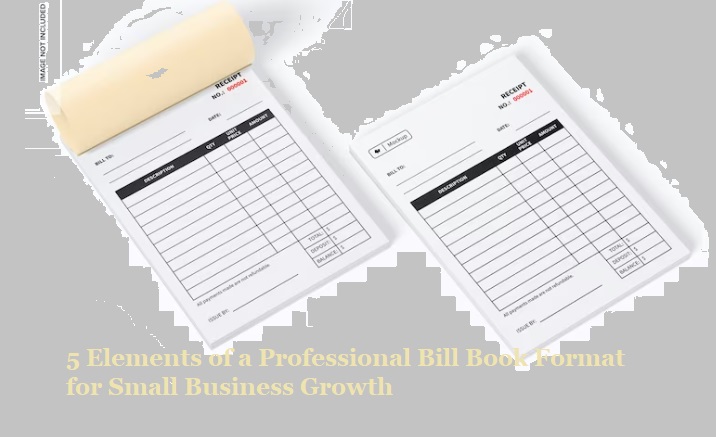5 Elements of a Professional Bill Book Format for Small Business Growth
Small businesses exist in a dynamic environment and setting up as a professional business is core to their survival. The bill book, which is probably one of the tools least addressed but almost centrally important in reaching this professionalism, plays a vital function. Regardless of whether you manage a cash-based shop, offer freelance services or manage an online venture; an orderly ledger book can strengthen your business’s reliability. It lays a foundation for consumers’ immersive experience and represents your brand identity. This article is about one of the important subjects ” the professional bill book format and its role in the growth and credibility of your business”. Now, we are going to delve into the finer details of this seemingly inconsequential and yet vital instrument.
Why Professional Bill Book Format is Necessary for Business Growth?
A professional bill book format plays a crucial role in the growth and success of a small business. It serves as the backbone of a company’s financial paperwork, capturing essential transaction details. There are 2 most useable formats, Let’s delve into their importance and their key formats :
The importance of a professional bill book format
The importance of a professional bill book format cannot be overstated. A properly designed bill book provides clarity, accuracy and professionalism on all financial transactions. It exactly serves as trustful historical records, helps businesses communicate with clients effectively and builds the image of goodwill. Starting from being a small business owner to a lonely freelancer, investing in any professional bill book format would play the role of the king and want and let you get to a position where your clients have the highest level of trust and confidence in you.

Credibility and Professionalism:
A well-designed bill book conveys professionalism and reliability to your clients. When you issue invoices or receipts using a standardized format, it instils confidence in your business.
Branding and Identity:
Your bill book serves as a branding tool. Incorporating your company logo, colors, and contact details ensures consistent branding across all transactions. It reinforces your business identity and helps clients remember your services.
Record Keeping and Organization:
Bill books maintain a systematic record of financial transactions. Each invoice or receipt is sequentially numbered, making it easy to track payments, monitor outstanding dues, and reconcile accounts.
Legal Compliance:
Properly formatted bill books ensure compliance with legal requirements. They include essential details such as GSTIN (Goods and Services Tax Identification Number), terms of payment, and other mandatory information.
Customer Communication:
Beyond financial transactions, bill books serve as a communication channel. You can include personalized messages, thank-you notes, or promotional offers, enhancing customer engagement.
A properly designed bill book facilitates the issuance of invoices, improves the business’s image and assists in maintaining faultless financial records. Bill books can be a good investment in terms of the growth and credibility of small businesses if done properly.
Let’s explore two key formats:
Standard Bill Book Format:
A standard bill book format serves as a crucial tool for businesses to document transactions accurately and professionally. Typically, it includes essential details such as the business name and contact information and customer details. It contains a unique invoice number, the date of the transaction, a detailed list of products and payment terms. This format not only ensures clarity and consistency in financial records but also enhances trust and transparency between the business and its clients. This widely used layout includes sections such as:
- Purchaser’s Information: Customer name, address and contact details.
- Item Description: Detailed breakdown of goods or services provided.
- Quantity: Number of items purchased or service duration.
- Unit Price: Cost per item or service.
- Total Cost: Final amount after taxes, discounts or additional charges.
Ideal for businesses dealing with physical goods, it facilitates clear transaction records and inventory management.
Professional Services Bill Book Format:
A professional services bill book format is tailored to cater to the billing needs of service-oriented businesses. Such as consulting firms, legal practices and freelance professionals. It prominently features service descriptions, hours worked or consultancy periods, rates per hour or fixed service fees, subtotals, applicable taxes and the total amount due. This format emphasizes the specifics of the services provided, ensuring transparency and facilitating. A clear understanding between the service provider and the client regarding the scope and cost of the services rendered.
Key sections include:
- Client Information: Client’s name, contact details, and address.
- Service Description: Explanation of tasks performed or goals achieved.
- Hours Worked: Time spent providing the service.
- Rate Per Hour: Charge for each unit of time.
- Total Cost: Calculated based on hours worked and rate per hour.
Provides transparency and precise billing for service-oriented professionals
Detailed Breakdown of Invoices:
Understanding the Core Components
Detailed invoice reports are an important way to ensure that there is clarity in the billing process for clients. Invoice is one of the major work tools in business management. Completeness of the approach encourages the parties on both sides of the transaction to have a clear understanding of the financial details, aiding in achieving the financial management results and dispute solutions if need be. It serves as an itemized receipt of a given sales transaction between a client and the vendor.
The core components of an invoice include:
- Invoice Number: A unique identifier for each invoice.
- Date: The transaction date when goods or services were provided.
- Business Contact Information: Details of the seller and buyer.
- Descriptions of Goods and Services: Clear breakdown of what was delivered.
- Payment Terms: Outlining payment due dates and terms.
By including these elements, invoices ensure clarity and facilitate smooth financial interactions between parties.
Incorporating Business Identity:
Logos, Contact Information and Branding
Incorporating business identity into invoices through logos, contact information and consistent branding is pivotal for reinforcing brand recognition and trust with clients. By integrating a company’s visual identity and essential contact details, businesses can ensure their invoices not only serve a functional purpose but also contribute to a cohesive brand experience. This strategy enhances professionalism, promotes brand consistency across all client interactions and helps make the business more memorable. Thereby supporting stronger client relationships and fostering business growth.

Let’s delve into the essential concepts of branding, identity design and logo design:
Branding:
- Definition: Branding encompasses the perceived emotional corporate image of an organization, service, or product. It is shaped by the audience’s perceptions.
- Role: Brand identity is not only a visual aspect with components like colour, font, logo and slogan but also more than that. In contrast, it will apply to all that a company does in addition to its ownership and operations. A confident brand identity reflects the core values and aspirations of the entire business.
- Key Takeaway: Effective branding establishes a cohesive brand image, making the business memorable and recognizable.
Identity Design:
- Definition: Identity design refers to the visual aspects that form part of the overall brand. It includes elements like logos, colour schemes, typography, and other visual components.
- Role: Identity design shapes how the brand appears visually to the audience. It provides consistency and recognition across various touchpoints.
- Importance: A well-crafted identity reinforces the brand’s personality and helps differentiate it from competitors.
Logo Design:
- Definition: A logo is a mark, flag, symbol, or signature that identifies a business or product. It represents the brand in its simplest form.
- Function: Logos serve as identifiers, not explanations. Their meaning derives from the quality of what they symbolize.
- Remember: A logo alone does not define the entire brand; it’s just one piece of the larger puzzle.
A strong brand identity emerges from effective branding, thoughtful identity design, and a well-crafted logo. These elements work together to create a memorable and easily identifiable brand.
Clarity in Payment Terms:
Due Dates, Penalties and Payment Methods
To ensure seamless financial transactions, it is necessary to create transparency in payment terms such as due dates, late payment penalties, and acceptable payment methods. Fair terms are implemented so that both parties will remain aligned in reaching an understanding which will reduce the chances of misinterpretations and payment delays. Indicating when the payments are due, the consequences of defaulting the payment and payment handling method; enables businesses to not only be in control of their cash but also keep their clients in good books.

Let’s explore the crucial aspects of payment terms, including due dates, penalties and payment methods:
Importance of Clear Payment Terms:
- Clear and well-structured payment terms are essential for any business.
- They serve as a roadmap, guiding clients on when and how to pay their invoices.
- Beyond timely payments, they play a significant role in maintaining steady cash flow and fostering trust with customers.
Cash Flow Connection:
- Cash flow refers to the money coming into and going out of a business.
- Clear payment terms impact cash flow:
- Positive Cash Flow: Timely payments allow accurate income prediction, smoother operations, and growth opportunities.
- Negative Cash Flow: Delayed transactions can lead to problems like difficulty paying suppliers or potential bankruptcy.
Fostering Trust with Clients:
- Clients rely on clear terms to understand when and how to pay.
- Establishing expectations upfront leaves no room for misunderstanding.
- Penalty System: Implementing a penalty for overdue payments reinforces the importance of timely payments. A late fee (often a percentage of the total invoice amount) can incentivize clients to pay on time.
Remember, clarity in payment terms contributes to a thriving business and stronger client relationships.
Legal Compliance and Taxation: Navigating Regulations within Your Bill Book
Being able to comply as a business owner with different regulations such as legal and tax obligations that apply to your particular industry and area is a task that you need to complete with care. A core element of compliance certainly is keeping an up-to-date cash diary which records all your transactions with your clients and suppliers. The bill book is not just a mandatory document, but also an administrative tool for budgeting, monitoring, and paying taxes. The rules which are associated with your bill book can be quite tough to solve, especially if you bridge several jurisdictions or go with different kinds of merchandise and services.
Here we will give some ideas and tips for how to begin and manage your bills book compliantly and efficiently for your company.

- A standard template that has all this necessary information can be provided as follows: Date, Invoice number, Customer name and address, contact details, description of services or goods, quantity, price, tax rate, total amount, payment method and signature.
- Updating the categories and keeping the bill book organized is a must; entering the transaction into the book as soon as it happens and storing the invoice chronologically is required.
- Try adopting a digital or cloud-based storage solution for your bill book, because it will be more secure, convenient and accessible than a paper-based solution. Additionally, you will be able to use accounting software or apps which will be able to create and send invoices automatically and account for your payments and receipts.
- Adhere to the tax laws and regulations that are related to your business like GST, VAT, income tax, and withholding tax. For this, you may have to register your business with the tax authority and to timely submit the returns and pay the tax on time. You could be asked to issue invoices or receipts as well as retain a log of your transactions for a while.
- Seek the advice of a professional accountant or tax consultant if you cannot be sure if your bill book meets the requirements. They may guide you through the environment of the legal parameters, to avoid penalties and obtain the highest tax benefits.
Legal Compliance and Taxation:
Navigating Regulations within Your Bill Book
Legal compliance and taxation are two aspects of doing business in India that come under the singular responsibility of enterprises. When you are a business owner, you must know about the different types of laws as well as regulations that apply to your industry, to the place where you operate your business, or to the nature of your transactions. You must accordingly watch over your income, expenses, and taxes, and report each clearly to the pertinent bodies. As a first step, your bill book serves as a tool to help you in this regard.
A bill book is a written record that includes details of every sale or purchase done by your business: the date, amount, description, GST number and the signature of the parties the process involves. A bill book not only confirms transactions but also offers data that can determine the tax or for the tax filing. When you maintain a well-structured bill book, you will have the capacity to ensure that your business complies with the legal and tax laws, avoid fines and disputes and increase the effectiveness of financial management.
What are some common tax mistakes to avoid in India?
Some common tax mistakes to avoid in India are:
- Filing ITR using incorrect tax form: You should choose the appropriate ITR form based on your income sources and eligibility criteria. Filing the wrong form can make your return defective or invalid12.
- Mentioning incorrect personal or correspondence details: You should verify your PAN, Aadhaar, address, email and mobile number before filing your return. These details are used by the Income Tax Department to communicate with you and send notices, refunds, and intimations.
- Not checking Form 26AS statement: Form 26AS is a general report containing your income, TDS, advance tax and self-assessment tax as well as other necessary details. Remember to triangulate your 26AS Form with your Form 16 and the other income sources to make sure that they don’t have any defects.
- Failure to report income from other sources: You should inform the revenue administration of any income source, irrespective of whether it is taxable or exempt, in your ITR. This covers the income from assets like interest, dividends, revenue from selling property, gifts, earnings from abroad, and many other sources. Penalty and scrutiny will be there if the income from these sources is not declared.
- Not considering the impact of tax reforms: Keep an eye on the recent amendments and replacements in the national tax code that could potentially change your tax amounts and deductible options.
You must be aware of the mistakes and current regulatory rules according to your customers and targeted market to prepare your bill book format for your small business needs.
Utilizing Technology:
Advancements in Digital Bill Book Solutions
Technology has revolutionized the way businesses manage their bill books. Instead of relying on paper-based or manual methods, businesses can now use digital bill book solutions that offer various benefits such as:
- Convenience: Digital bill book solutions allow businesses to create, send and receive bills anytime, anywhere, using their smartphones, tablets or computers. They also enable businesses to store and access their bills in the cloud, eliminating the need for physical storage and maintenance.
- Accuracy: Digital bill book solutions reduce the chances of human errors, such as miscalculations and typos. Or omissions, that can lead to disputes and penalties. They also ensure that the bills comply with the latest tax laws and regulations such as GST, e-invoicing and e-way bills.
- Efficiency: Digital bill book solutions automate and streamline the billing process, saving time and resources for businesses. They also facilitate faster payments and collections, improving the cash flow and profitability of businesses.
- Security: Digital bill book solutions protect the data and privacy of businesses and their customers, using encryption, authentication and backup features. They also prevent fraud, theft, or loss of bills, by providing digital signatures, receipts and audit trails.
Digital bill book solutions are the future of billing, as they offer convenience, accuracy, efficiency and security to businesses and their customers. By utilizing technology, businesses can improve their billing management and enhance their customer satisfaction.
Best Practices for Maintaining and Updating Your Bill Book Format:
- Use a standard template: Adopt a standard system that entails the inclusion of all fundamental values such as invoice number, date, customer details, item description, quantity, price, tax rate, payment terms and signature.
- Keep your bill book updated: Promptly recording in the books and maintaining orderly records will ensure the accuracy of accounting and conformity to legal requirements.
- Utilize digital solutions: Incorporate digital bills online to improve your satisfaction, accuracy, effectiveness, and security. Digital platforms grant features of cloud storage, automation and encryption to expedite your billing process and safeguard your core data.
- Ensure clarity in payment terms: Duly specify due dates, latest penalties for late remittance, and acceptable payment options to rule out confusion and delays in payments.
- Stay compliant with legal and taxation regulations: Familiarize yourself with tax laws and tax regulations that apply to your business and see to it that your book meets the required legal standards. Work with an expert accountant or a tax consultant (if necessary) to prevent penalties and utilize advantages to the fullest extent.
Conclusion:
In conclusion, a professional bill book format is an essential tool for small businesses to maintain professionalism, facilitate financial transactions and enhance brand image. Whether you opt for a standard or professional services format, clear payment terms, detailed invoices and compliance with legal and taxation regulations are crucial for business success. Embracing technology with digital bill book format further streamlines billing processes and ensures accuracy and security. By prioritizing these elements, businesses can foster trust with clients, maintain efficient financial management and contribute to overall growth and credibility.




